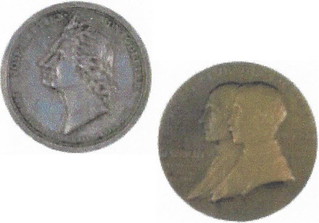
PREV ARTICLE
NEXT ARTICLE
FULL ISSUE
PREV FULL ISSUE
THE RICHARD GIMBEL AERONAUTICAL COLLECTIONHarry Waterson writes:David Lange’s piece on Robert Friedberg jogged my memory. Gimbels not only contributed to coin collecting at the commercial level but one of the sons of the Gimbel Brothers amassed one on the great aeronautical collections in the US. I do not think Friedberg had any influence on Richard Gimbel who had worked at Gimbels until 1935. Friedberg did not start at the department store until 1947 according to my research but they were contemporaries so maybe they knew each other.
Harry attached a brochure with the story of the collection. Thanks! Here's an excerpt. -Editor
The Gimbel collection is extraordinarily diverse. Five-thousand-year-old cylinder seals carved from semi-precious stones depict mankind's earliest dreams of flight. Rare coins and medals commemorate the great aviators and their achievements. Sheet music records aerial melodies. More than 5,000 books address every aspect of aviation, including early experiments with wings, balloon ascents, the first parachutes, rocketry, and detailed accounts of historic flights. Montgolfier and Wright Medals
Richard Gimbel collected more than just aeronautics literature, and he collected on a grand scale. He's more background from Wikipedia. -Editor
After taking a year off to travel the world, Gimbel worked for his family's business overseeing the construction of their Philadelphia store in 1927 and then as a vice president of Gimbel Brothers Company. In 1935, he left Gimbel Brothers after a dispute with his cousin Bernard Gimbel over strategy and moved to Miami where he profitably ran a Richards store. In 1940, he joined the Army Air Corp as a lieutenant colonel and with the Eighth Air Force as a pilot during World War II. In 1951, he was appointed Professor of Air Science and Tactics at Yale University. In 1953, he retired as full colonel in 1953 and stayed with the library as curator of aeronautical literature. In 1942, during the London blitz, he visited a bombed-out bookstore in London and purchased a trunk of aeronautical books. Thereafter, he was a voracious collector of books specializing in Charles Dickens, Edgar Allan Poe, and Thomas Paine in addition to anything aeronautical. He purchased the Philadelphia home of Edgar Allan Poe, filled it with his non-aeronautical collection, and presented it to the city of Philadelphia as the Edgar Allan Poe House and Museum. Upon his death, he had over 100,000 items in his aeronautical collection. To read the complete article, see:
To read the earlier E-Sylum article, see:

Wayne Homren, Editor The Numismatic Bibliomania Society is a non-profit organization promoting numismatic literature. See our web site at coinbooks.org. To submit items for publication in The E-Sylum, write to the Editor at this address: whomren@gmail.com To subscribe go to: https://my.binhost.com/lists/listinfo/esylum All Rights Reserved. NBS Home Page Contact the NBS webmaster 
|

